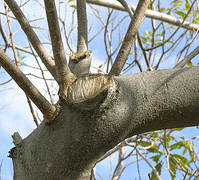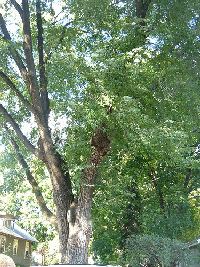Pruning Large Trees requires experience and proper equipment, consider calling a professional
It is important to understand first why you need to prune trees.
Prune for tree health, which involves removing dead, broken or diseased branches. Opening up the crown by thinning will increase air circulation and allow sunlight in.
Prune for strong structure, removing branches that cross or touch each other.
Prune for safety, including keeping limbs clear of power lines and limbs that block view when entering or exiting a driveway. But also to allow clearance where necessary for mowing, trimming or just passing under.
Prune to improve or enhance the form or character of the tree, or to increase flower production.
Never prune just because you think you should. Most trees will develop a pleasant natural form on their own. Dead, broken or diseased branches should definitely be pruned for the health of the tree. Otherwise be cautious or call a professional. Small branches easily removed with a lopper or pruning saw you need not worry about. Larger branches that require more serious equipment require more serious thought.
Just as important is when you should prune your trees.
Prune trees when dormant after the leaves have fallen so you can easily see the structure.
Prune trees when dormant to reduce sap flow and disease and insect exposure.
Prune trees that flower in early spring immediately after flowering as flower buds are formed the season prior to the bloom.
Prune trees that flower in summer or fall when dormant, as flower buds are formed on spring growth.
Although pruning a shade tree need not be complicated it does require thoughtful assessment. It may also require a professional with professional equipment. Climbing a tree with large sharp tools or a chain saw, or operating a saw on a tall ladder is not safe for the inexperienced. If your tree is not too large and you decide to tackle the pruning yourself, well maintained equipment and sharp clean tools are a must.
Trees with a pyramid form typically have one strong central leader. Trees with a more rounded form often have lateral branches that will compete with the central leader for dominance. The rounded crowns are most often the ones that require pruning to maintain the strong central leader and strong uniform branching.
Before making a cut, or the final cut in branch removal, locate the branch collar. This is where the branch joins either the main trunk or a primary lateral branch. The collar is sometimes quite evident as a defined ridge all the way around the joint. Sometimes it is not much more than a ridge in the bark. Your final removal cut should be just outside that collar or ridge, angling down and away from the tree. The natural tendency to cut a branch flush with the trunk or adjoining branch is common and removes the branch collar. A final cut inside the collar can prohibit proper healing, cause a weak structure and unnatural growth such as watersprouting as shown at left. Cutting too far outside the collar will cause branch dieback, the decay inviting problems.
Large branches need to be removed making three separate cuts. If you try to remove a heavy branch in a single cut, the weight of the branch will pull it down before you finish, tearing the bark (not to mention pinching and trapping your chain saw, a difficult predicament to get out of). First cut a notch on the underside of the branch outside of the branch collar. The next cut should be clear through the branch but outside of the notch. Now you have a small manageable stump to remove between the collar and the first notch.
Pruning for health and strong structure: Thinning the Crown
Thinning the crown of the tree can improve the strength and structure of the tree as well as allow air and sun access to the central limbs of the tree. Begin by removing all branches that cross each other or touch each other. The branches should be removed at the point that it attaches to another branch, which is a node, and paying close attention to branch collars as mentioned. Sometimes that is enough, and if you are pruning in the dormant season you can clearly see the branch structure to properly evaluate. If additional pruning seems necessary, remember that you should never remove more than 25 percent of the crown in one season. Next you should select branches that grow either strongly upward, or strongly downward. Select a few branches to remove spaced throughout the crown. Lateral branches should be somewhat evenly spaced along the trunk. Examine the union at the base of the branch. A strong union forms a U shape, a weaker union is more closed, forming a V or the reverse a very wide union. This does NOT mean that every weak union should be removed! Select branches to remove with a weak union, but bear in mind that some species naturally grow with weaker V shaped unions, such as the Elm shown at right. In that case, evaluate the overall structure, then err toward the weakest unions. Remember that it is better to remove too little than too much. Evaluate the work in the next growing season and you can remove additional branches next dormant season if necessary.
Pruning for Safety: Raising the Crown
Trees along the street or sidewalk may need to be pruned to allow pedestrian traffic to pass underneath and to clear sight lines for traffic. Trees in the landscape may also need to be pruned to allow passage for mowing, trimming or just passing through the lawn. Simply remove all branches outside the branch collar where they join the trunk up to a comfortable level for pedestrians to pass. Never remove more than one third the height of the crown in one season. Again, more can be removed in the next dormant season if necessary.
Pruning for Safety: Reducing the Crown
Poor planning may result in a tree growing into overhead power lines. Trees are often “topped” (simply sheared straight across the top) to relieve the situation, causing an unsightly form and unnatural regrowth. Likewise, the random reduction of branch length midway can cause watersprouting as seen at right.
Instead, remove the tallest sections of the crown from the interior at a level substantially lower than the required high point. Select a “cluster” of branches to be removed and find its main joint to the tree. The lateral branch that will remain should be at least one third the diameter of the branch you remove. This will generally be a section that is too large to handle in one cut and should be removed in manageable portions until the selected joint is reached. Use the 3 step cutting method to make this final removal also. Lateral outward facing branches can remain to help balance the crown structure. Although this example is still quite severe, the idea is clearly illustrated. And the tree retains a somewhat more natural form, and grows stronger and healthier.
Sound too complicated? Big job? Please, call a professional.





